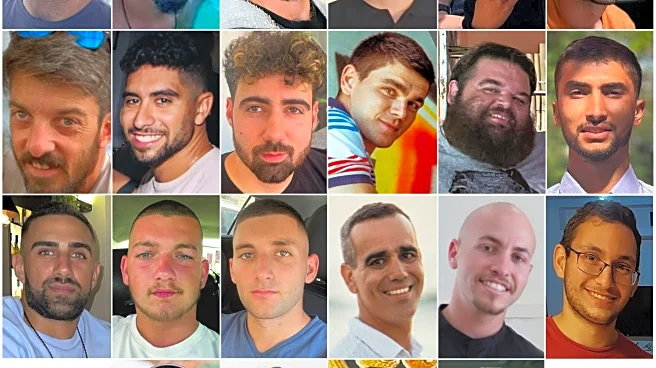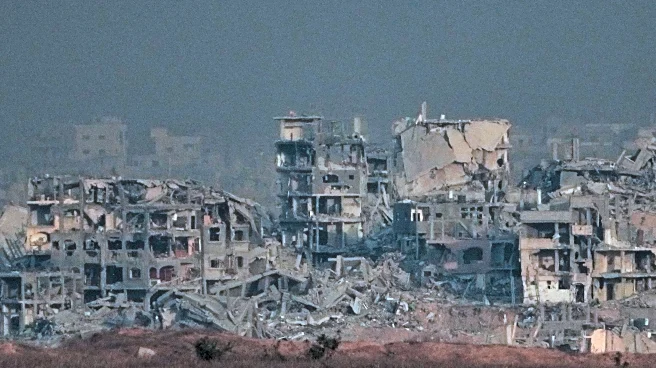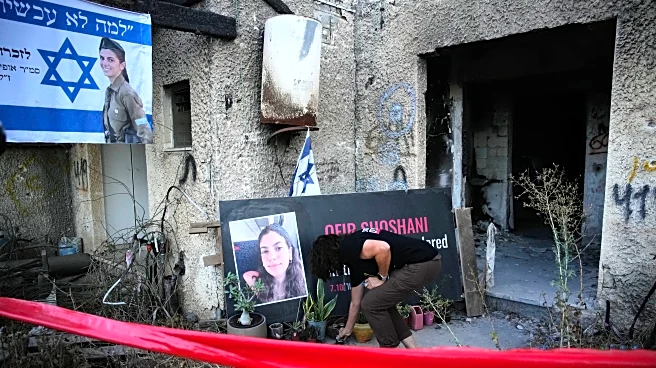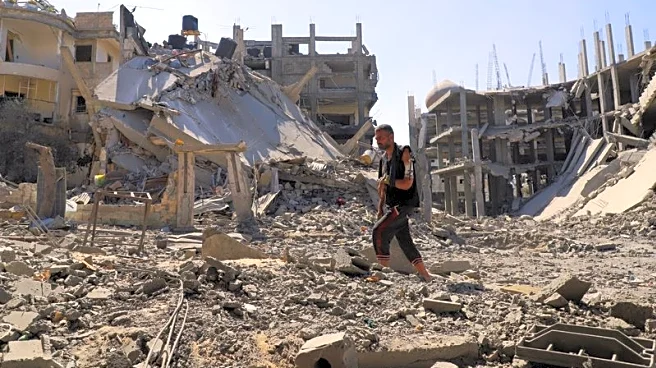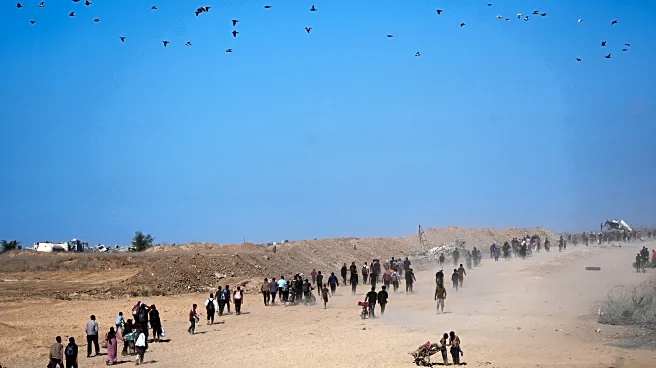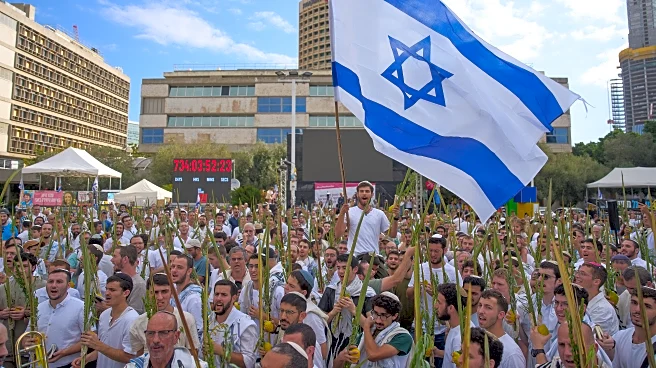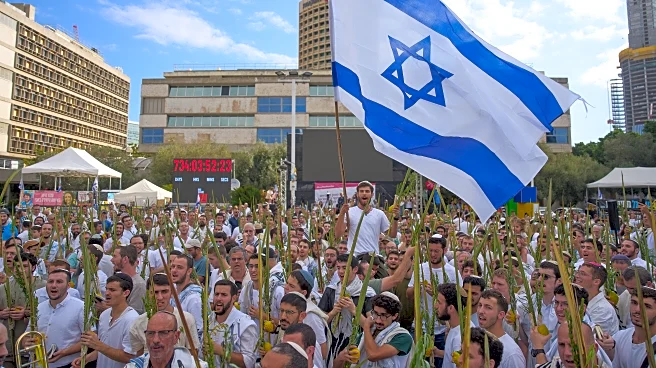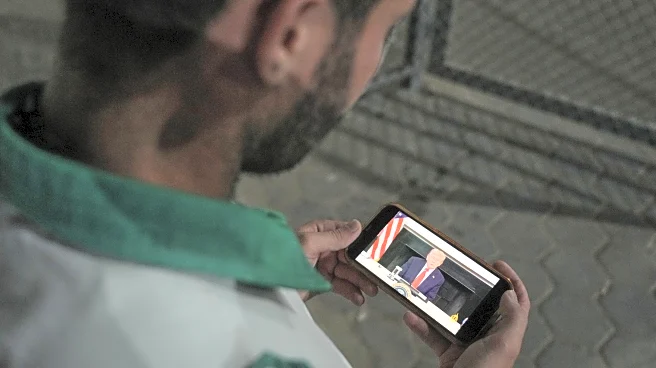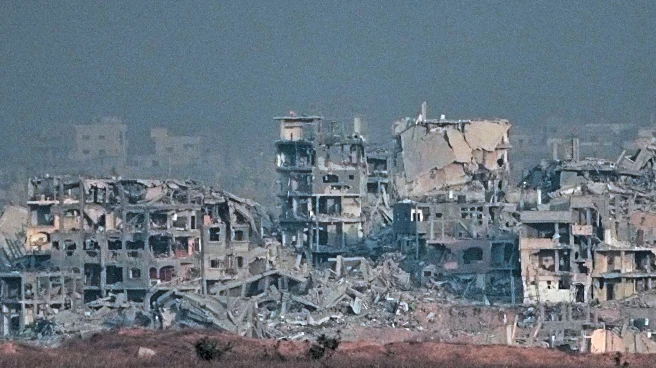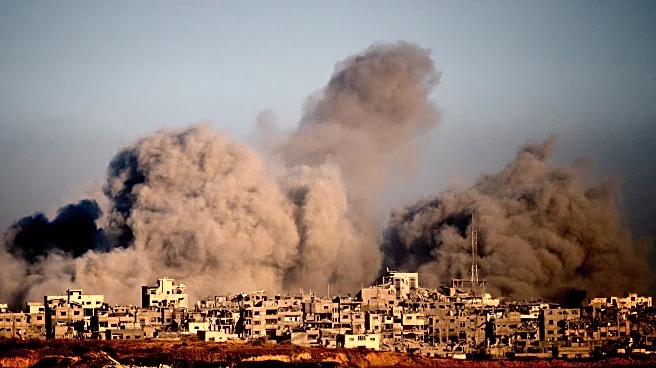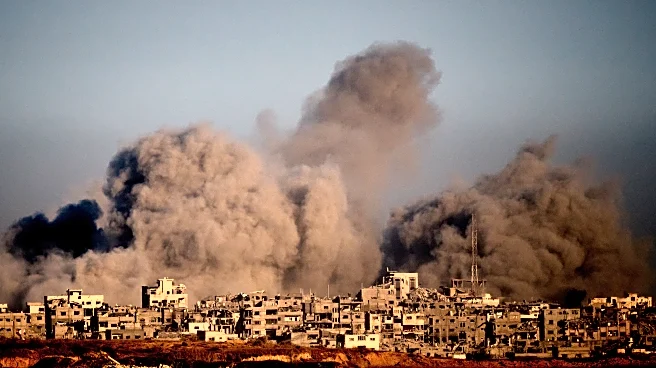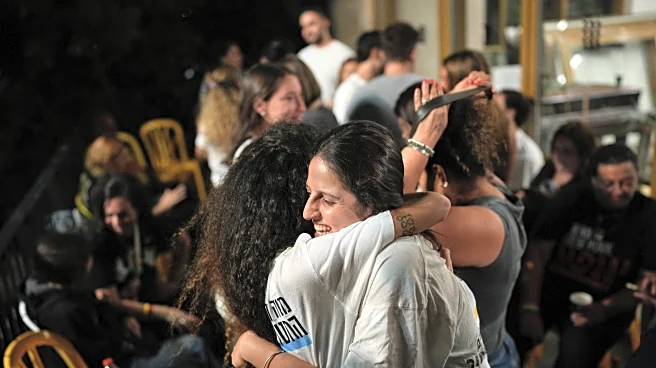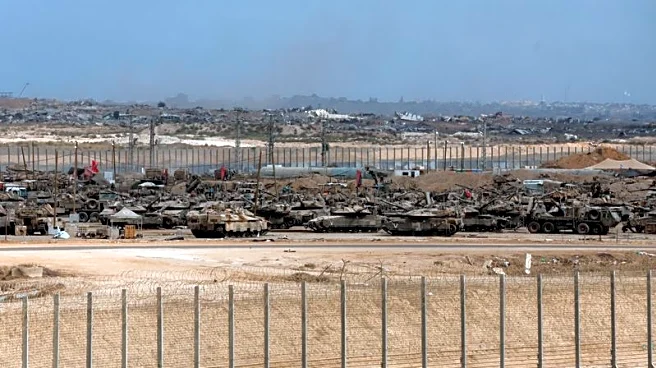TEL AVIV, Israel (AP) — Their faces stare down from every street corner in Israel on posters now sun-faded and ripped. Their stories, told by anguished family members, are almost as well-known as celebrities. They are civilians and soldiers, fathers and sons. Some were at the Nova music festival, where almost 400 people were killed and dozens kidnapped.
The latest ceasefire, which began Friday, marks a key step toward ending a ruinous two-year war that
was triggered by Hamas’ Oct. 7, 2023, attack on Israel, when some 1,200 people were killed and 251 kidnapped.
The fighting has killed 67,000 Palestinians, according to Gaza’s Health Ministry, which doesn’t differentiate between civilians and combatants but says around half the deaths were women and children, and displaced around 90% of the Gaza population of some 2 million. The ministry is part of the Hamas-run government, and the United Nations and many independent experts consider its figures to be the most reliable estimate of wartime casualties in Gaza.
There are currently 48 hostages being held in Gaza, including the body of one soldier from a previous war. Israel has determined that at least 25 of the hostages were killed on Oct. 7, 2023, or died while in captivity. It is unclear how many of the remaining around 20 hostages are still alive and will return to Israel. There is only one remaining female hostage, who Israel believes was killed in captivity.
With the start of the ceasefire on Friday, the remaining hostages are expected to be released within 72 hours. Israel is set to release around 2,000 Palestinian prisoners in exchange.
Here is a look at 22 hostages Israel believes are still alive.
Matan Angrest, an Israeli soldier, was kidnapped from his military tank in southern Israel. He is the oldest of four children from Kiryat Bialik, outside of Haifa. His family has been among the most vocal protesters and very critical of Prime Minister Benjamin Netanyahu. On Tuesday's two-year anniversary of the Oct. 7 attack, his mother, Anat Angrest, addressed her son at a rally. “I know you’re in pain, and I can’t hug you. I hear you whisper, ‘Come for me, Mom,’ and I can’t protect you," she said.
The fraternal twins were taken from their homes in kibbutz Kfar Aza, on the border with Gaza, during the Oct. 7 attack. Seventeen others were also abducted from Kfar Aza, but the Berman twins are the only hostages from the kibbutz who remain in captivity. The family has heard from hostages who returned in a previous deal that, as of February, the brothers were alive but being held separately. Liran Berman, their older brother, said it’s the longest the two have ever spent apart. In Kfar Aza, the twins lived in apartments across from each other. Gali is more outgoing, while Ziv is more reserved and shy with a sharp sense of humor, their brother said.
Elkana Bohbot was kidnapped from the Nova music festival. In the past year, Hamas has published multiple videos of Bohbot, filmed under duress, including one where he has a fake telephone conversation with his wife, Rivka; their son, Reem; his mother and his brother — pleading with them to help him get out of Gaza. His son made binoculars in kindergarten which he often uses to go out and “look for his father,” according to Bohbot’s mother, Ruhama.
Braslavski was working as a security guard at the Nova festival. He attempted to help festival goers evacuate and was wounded in both hands before being kidnapped, witnesses said. In August, the Islamic Jihad militant group released a video of a skeletal Braslavski sobbing and pleading for his life, adding that injuries to his foot prevent him from standing. The videos of Braslavski and Evyatar David digging his own grave horrified Israelis, sparking some of the largest attendance in months at weekly protests. His father, Ofir, said Rom is usually a strong, happy-go-lucky kid, and that video is the first time he’s seen his son cry.
Nimrod Cohen was kidnapped from a tank where he was stationed as a soldier in southern Israel. Cohen is obsessed with Rubik's cubes, his family said, and a burned Rubik's cube was found in the tank he was abducted from. This year, his mother, Viki Cohen, illustrated a Passover haggadah, the text laying out the rituals and story recited during the Passover holiday, in honor of hostages, partly because her family has stopped celebrating holidays since the attack. “We don’t gather as a family, because it reminds us how much he is missing,” Cohen said. The only time the extended family gathers is at protests, she said.
The youngest of four Cunio brothers, Ariel was kidnapped from the Nir Oz kibbutz with his girlfriend, Arbel Yehoud, and her brother, Dolev, a married father of four who was later killed in captivity. According to news reports, Cunio and Yehoud had returned from an extended trip to South America weeks before the attack and had just adopted a puppy. Yehoud was released during the ceasefire in January.
David Cunio, brother of Ariel Cunio, was kidnapped with his wife, Sharon, and their 3-year-old twins from the Nir Oz kibbutz. Sharon’s sister Danielle and her 5-year-old daughter, who were visiting, also were kidnapped. All were released in November, except for David Cunio. In July, Sharon shared a photo of the twins marking their fifth birthday, their second without their father, writing on Facebook that the girls have changed so much while he’s been in captivity that “they’re not the same little girls he knew.”
Evyatar David was taken hostage at the Nova music festival along with his childhood friend, Guy Gilboa-Dalal. In August, Hamas released a video of David, gaunt and pale, who said he was digging his own grave. The condition of the hostages in the videos horrified Israelis and led tens of thousands of protesters to take to the streets and demand a ceasefire deal, in one of the largest turnouts for the weekly hostage protests in months.
Guy Gilboa-Dalal was among those abducted from the Nova music festival, while his brother managed to escape. In the past year, he’s appeared in two videos released by Hamas. In one, he appears alongside his childhood friend, David, with militants filming them pleading for their freedom in a vehicle while they watch three other hostages on stage being released to the Red Cross.
Maksym Harkin was abducted from Nova, which was the first festival he had ever attended, according to his family. Harkin was born in Ukraine and moved to Israel with his family, where he lived in Tirat HaCarmel in the north. He has a 3-year-old daughter and was the primary provider for his mother and 11-year-old brother. Just before he was taken, his mother said he sent a final text message that said, “I love you.” In July, Hamas released a video of him filmed under duress several months prior.
Eitan Horn, originally from Kfar Saba, was visiting his brother Iair at the Nir Oz kibbutz on Oct. 7. Both were kidnapped. For most of the war, the two were held with three other hostages in a filthy cell underground. In early February, militants filmed the emotional interaction between the brothers as they were told that Iair would be released and Eitan would stay in Gaza. Since his release, Iair Horn has campaigned for his brother and the other hostages, flying frequently to the United States and meeting with politicians.
Bipin Joshi arrived in Israel from his native Nepal a month before the attack. He is the only non-Israeli hostage believed to be alive in Gaza. He came to Israel on a student exchange to work and study agriculture at kibbutz Alumim on the Gaza border. Ten of the 17 Nepali students in the program were killed during the attack. Joshi, who was able to throw a number of live grenades out of the bomb shelter where they were hiding, was injured and kidnapped. Joshi’s sister, 17-year-old Pushpa Joshi, regularly travels eight hours each direction on buses to Kathmandu from her home in western Nepal to lobby officials to secure her brother’s release. In August, his family traveled to Israel to meet with President Isaac Herzog and join families demonstrating in Tel Aviv’s Hostage Square.
Segev Kalfon was kidnapped from the Nova music festival, where he was last seen attempting to flee militants along the highway. Before the attack, he worked at his family’s bakery in Dimona, in southern Israeli. The middle child of three, Kalfon had recently been diagnosed with an anxiety disorder, a condition his family has highlighted in urging his release. Kalfon’s family received a sign of life from him after the last ceasefire, when some of the hostages said they were held with him for months. Kalfon’s family has focused on religious rituals in their fight for his release, including traveling to the grave of prominent rabbis and dedicating a Torah scroll in his honor.
Bar Kupershtein was working at the Nova festival as a security guard when he was abducted. Witnesses said Kupershtein stayed at the festival to try to provide first aid to people who had been shot and injured. Kupershtein was the main financial support for his family after his father was severely injured in an accident several years ago, his aunt, Ora Rubinstein, told reporters. She said that his father worked with a physical therapist to regain the ability to speak, so he could meet with politicians to advocate for his son’s release. He has told the family that he will walk again when his son comes home, she said.
Omri Miran was kidnapped from the Nahal Oz kibbutz. During the attack, militants held his family, including his two daughters, ages 2 and 6 months, hostage in the kitchen of a neighbor’s house and then broadcast it on Facebook Live. Miran and the father of the other family, Tsachi Idan, were kidnapped. Idan’s body was released during the last hostage exchange after he was killed in captivity. Lishay Miran Lavi, Miran’s wife, said their younger daughter knows “daddy Omri” only through photos and videos, and doesn’t really understand what a father is.
Eitan Mor was working as a security guard at the Nova music festival, where he helped evacuate people injured in the attack. Mor’s parents helped found the Tikva Forum, a loosely organized group of hostage families. They advocated for military pressure, not an immediate ceasefire or hostage release deal, as the best chance for bringing the hostages home. That stance has put Mor’s father at odds with many of the other families of hostages.
Tamir Nimrodi was kidnapped from Erez, a crossing on the northern border of Gaza that had been the main route for people entering and leaving the territory. He had been serving with the Israeli defense body overseeing humanitarian aid in Gaza. Nimrodi was kidnapped with two other soldiers by militants who walked them to the Gaza gate and forced them to cross. Israel confirmed the deaths of the two soldiers who were kidnapped with Nimrodi. There has been no sign of life from Nimrodi in the two years since he was seen in footage walking into Gaza in shorts and a T-shirt without his glasses. Herut Nimrodi, his mother, has said she doesn’t know what is worse: to think he has been killed in captivity, or that he’s alive but being held in terrible conditions. “I’m scared to even imagine,” she said.
Yosef-Chaim Ohana was kidnapped from the Nova music festival, where he was working as a bartender. Witnesses saw him attempting to help others escape before he was kidnapped. He is the oldest of three brothers, one of whom previously died from an illness.
Alon Ohel, who also has German and Serbian citizenship, was kidnapped at the Nova music festival from a mobile bomb shelter along with Hersh Goldberg-Polin, an American-Israeli who was killed in captivity in August 2024. A talented pianist, his family has placed pianos across Israel and several sites around the world to raise awareness of his plight. Three other hostages who had been held with Ohel for more than a year were released during the previous ceasefire, including Eli Sharabi, who said Ohel was like his adopted son. Sharabi said they were kept chained for the entire period of their captivity and subsisted on a moldy pita per day. Ohel has shrapnel in his eye from the attack on the bomb shelter and his family is worried he may be partially blind.
Avinatan Or was kidnapped from the Nova music festival along with his girlfriend, Noa Argamani, who was rescued by Israeli forces in June 2024. On Oct. 7, Hamas released a video of the pair that has become one of the most well-known videos from that day. It showed Argamani on an all-terrain vehicle crying, “Don’t kill me!” and reaching out her arms to Or, who is being marched away from her by militants. Or worked in hi-tech in Tel Aviv before his abduction.
Matan Zangauker was kidnapped from kibbutz Nir Oz along with his girlfriend, Ilana Gritzewsky. The two met while working on a medical cannabis farm there. Gritzewsky was released after 55 days and has since advocated tirelessly for his release, wearing a hat of Zangauker’s she rescued from their burned home. His mother, Einav, has been a constant presence at protests, giving impassioned speeches and even being hoisted in a cage above the crowd to draw attention to the hostages’ plight. Zangauker, who said she was previously a Netanyahu supporter, has emerged as one of his harshest critics. ___
Associated Press writer Sam Metz contributed from Jerusalem.
